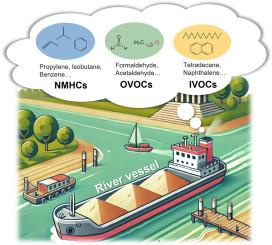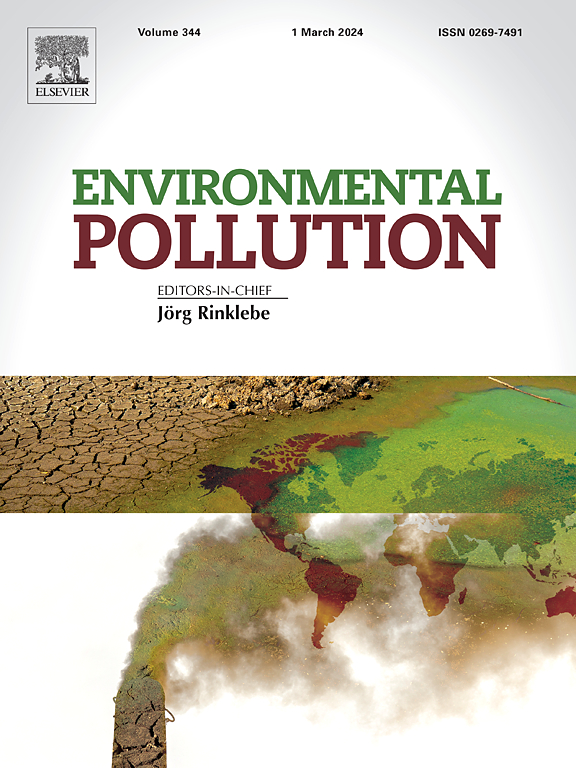在船上测量各种运行条件下内河船舶排放的有机蒸汽
IF 7.6
2区 环境科学与生态学
Q1 ENVIRONMENTAL SCIENCES
引用次数: 0
摘要
内河船舶污染物的排放因子和特征对于了解船舶排放对环境的影响至关重要,尤其是在内河航道。然而,关于内河船舶排放的挥发性有机化合物 (VOC) 和中间挥发性有机化合物 (IVOC) 的研究仍然存在空白。在这项研究中,我们收集并分析了三艘内河船舶在不同操作条件下排放的有机蒸汽,包括非甲烷碳氢化合物 (NMHC)、含氧挥发性有机化合物 (OVOC) 和 IVOC。结果表明,内河船舶的非甲烷总烃和 IVOC 平均排放系数明显高于远洋船舶。内河航道靠近居民区,增加了污染物向城市环境迁移的风险,从而提高了管理内河船舶排放的重要性。值得注意的是,与主机相比,老式辅机的有机蒸气排放量更高,这说明需要对老式发动机采取更好的控制措施。通过分析内河船舶有机蒸汽的排放特征,我们发现,与其他污染源以 C12 正构烷烃为主的 IVOCs 不同,内河船舶废气中 C12-C15 正构烷烃的贡献率相似,其中 C14 正构烷烃的贡献率最高。OVOC 占有机蒸汽臭氧形成潜能值的 50%以上,而 IVOC 则占二次有机气溶胶(SOA)形成潜能值的 90%以上。鉴于这些研究结果,应优先开展有针对性的工作,减少内河船舶的 OVOCs 和 IVOCs 排放,以减轻其对环境的影响。本文章由计算机程序翻译,如有差异,请以英文原文为准。

Onboard measurements of organic vapor emissions from river vessels under various operational conditions
The emission factors and characteristics of pollutants from river vessels are critical for understanding the environmental impact of ship emissions, particularly in inland waterways. However, research gaps remain regarding emissions of volatile organic compounds (VOCs) and intermediate-volatility organic compounds (IVOCs) from river vessels. In this study, we collected and analyzed organic vapor emissions, including non-methane hydrocarbon (NMHCs), oxygenated volatile organic compounds (OVOCs) and IVOCs, from three river vessels under different operating conditions. The results show that the average emission factors of NMHCs, and IVOCs from river vessels are significantly higher than those from ocean-going vessels. Inland waterways’ proximity to residential areas increases the risk of pollutant transport to urban environments, heightening the importance of managing river vessel emissions. Notably, older auxiliary engines displayed higher organic vapor emissions compared to main engines, underscoring the need for better control measures for aging engines. By analyzing the emission characteristics of organic vapors from river vessels, it was found that, unlike other pollution sources where C12 n-alkanes are the major contributors of IVOCs, the contributions of C12-C15 n-alkanes in river vessel exhaust are similar, with C14 n-alkane having the highest contribution. OVOCs constituted more than 50% to ozone formation potentials of organic vapors, while IVOCs were responsible for over 90% of the secondary organic aerosol (SOA) formation. Given these findings, targeted efforts to reduce OVOCs and IVOCs emissions from river vessels should prioritized to mitigate their environmental impact.
求助全文
通过发布文献求助,成功后即可免费获取论文全文。
去求助
来源期刊

Environmental Pollution
环境科学-环境科学
CiteScore
16.00
自引率
6.70%
发文量
2082
审稿时长
2.9 months
期刊介绍:
Environmental Pollution is an international peer-reviewed journal that publishes high-quality research papers and review articles covering all aspects of environmental pollution and its impacts on ecosystems and human health.
Subject areas include, but are not limited to:
• Sources and occurrences of pollutants that are clearly defined and measured in environmental compartments, food and food-related items, and human bodies;
• Interlinks between contaminant exposure and biological, ecological, and human health effects, including those of climate change;
• Contaminants of emerging concerns (including but not limited to antibiotic resistant microorganisms or genes, microplastics/nanoplastics, electronic wastes, light, and noise) and/or their biological, ecological, or human health effects;
• Laboratory and field studies on the remediation/mitigation of environmental pollution via new techniques and with clear links to biological, ecological, or human health effects;
• Modeling of pollution processes, patterns, or trends that is of clear environmental and/or human health interest;
• New techniques that measure and examine environmental occurrences, transport, behavior, and effects of pollutants within the environment or the laboratory, provided that they can be clearly used to address problems within regional or global environmental compartments.
 求助内容:
求助内容: 应助结果提醒方式:
应助结果提醒方式:


